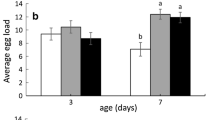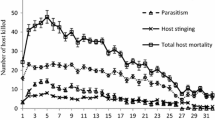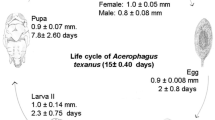Abstract
Laboratory trials designed to investigate the biology of the gregarious endoparasitoidPsychophagus omnivorus (Hym.:Pteromolidae) on pupae of the pest speciesChrysodeixis chalcites, Spodoptera exigua orLacanobia oleracea (Lep.:Noctuidae) reveal that each of these candidate hosts can be used as oviposition sites. In all cases, wasp fecundity is high and generation is rapid. A minimum of 10 daughters is produced by eachP. omnivorus female every 3.5 weeks. Patterns of host attack and the distribution of wasp brood size vary according to the identity of the available host.Chrysodeixis chalcites andL. oleracea pupae are attacked at a moderate rate, but individual hosts support large broods. By contrast, individualS. exigua hosts sustain smaller broods, but these hosts are parasitised at a higher rate. WhenP. omnivorus encountersC. chalcites orL. oleracea, most host-attacks occur within the first 10 days of her adult lifespan. However, whenP. omnivorus is presented withS. exigua the oviposition period is prolonged until the fifth week of host-exposure. These differences between the oviposition strategies adopted byP. omnivorus against each host type have implications for its use as a biocontrol agent.
Résumé
Des essais en laboratoire ont été réalisés pour étudier la biologie de l’endoparasitoïde grégairePsychophagus omnivorus (Hym.:Pteromalidae) sur les pupes de 3 espèces de ravageurs;Chrysodeixis chalcites, Spodoptera exigua etLacanobia oleracea (Lep.:Noctuidae). Ces essais montrent que l’endoparasitoïde peut pondre dans chacun de ces hôtes potentiels. Dans tous les cas, la fécondité est élevée et le renouvellement des générations rapide; un minimum de 10 descendants femelles est produit par chaque femelle deP. omnivorus toutes les 3,5 semaines. Les caractéristiques de l’attaque de l’hôte ainsi que la taille de la ponte varient en fonction du type d’hôte disponible. Les pupes deC. chalcites etL. oleracea, sont attaquées à un taux modéré, mais chaque hôte attaqué comporte un nombre important de parasitoïdes. Inversement, chaqueS. exigua hôte comporte une ponte plus faible, mais le taux de parasitisme pour cette espèce est plus élevé. LorsqueP. omnivorus rencontreC. chalcites ouL. oleracea, la plupart des attaques contre l’hôte ont lieu dans les 10 premiers jours de la vie imaginale du parasitoïde. Cependant lorsqueP. omnivorus est mis en présence deS. exigua, la période de ponte se prolonge jusqu’a la cinquième semaine d’exposition à l’hôte. Ces différences observées entre les stratégies de ponte adoptées parP. omnivorus en fonction du type d’hôte ont des implications dans son utilisation en tant qu’agent de lutte biologique.
Similar content being viewed by others
References
Afify, A. M. &Matter, M. M. — 1970. Zunemuende toleranz (LT-werte) vonAnagasta kühniella Z. gegenBacillus thuringiensis mit dem Alter der Larvalentwicklung. —Anz. Schädlingskd. Pflanzenschutz, 43, 97–100.
Alvarado-Rodriguez, B. — 1987 Parasites and disease associated with larvae of beet armywormSpodoptera exigua (Lepidoptera: Noctuidae), infesting processing tomatoes in Sinaloa, Mexico. —Fla Entomol., 70, 444–449.
Anonymous. — 1972. Distribution maps of pests. Pest:Spodoptera exigua (Hb.). Series A, map no. 302.CAB, London.
Arbatskaya, Ye. S. — 1958. A Short Overview of Attempts to ControlHyphantria cunea Drury in Natural Conditions in Slovakia.Trans. Int. Conf. Insect Pathol. Biol. Control Prague, 589–595.
Balachowsky, A. S. — 1972. Entomologie Appliquée à l’Agriculture. Tome II. Lépidoptères.Masson et Cie, 1634 p.
Brown, E. S. &Dewhurst, C. F. — 1975. The genusSpodoptera (Lepidoptera: Noctuidae) in Africa and the near East. —Bull. Ent. Res., 65, 221–262.
Broza, M. & Sneh, B. —Bacillus thuringiensis ssp.Kurstaki as an effective control agent of Lepidopteran pests in tomato fields in Israel. —J. Econ. Entomol., 87, 923–928.
Corbitt, T. S., Bryning, G., Olieff, S. &Edwards, J. P. — 1996. Reproductive, developmental and nutritional biology of the tomato moth,Lacanobia oleracea (Lepidoptera: Noctuidae) reared on artificial diet. —Bull. Ent. Res., 86, 647–657.
Crook, N. E. — 1981. A comparison of the granulosis viruses fromPieris brassicae andPieris rapae. —Virology, 115,173–181.
Fitton, M. G., Gauld, I. D., Roberts, L. I. N. &Walker, A. K. — 1983. An African ichneumonid (Hymenoptera) in Australasia. —Bull. Ent. Res., 73, 465–468.
Flanders, S. E. — 1950. Regulation of ovulation and egg disposal in the parasitic Hymenoptera. —Can. Entomol., 82, 134–140.
Foster, G. N. — 1979. Cultural factors affecting pest incidence in glasshouse tomato crops. — Proc. Br. Crop Prot. Conf. — Pests and Diseases, 441–445.
Foster, G. N. — 1981. Pest problems of glasshouse tomatoes in the West of Scotland. — Proc. Crop Prot. Northern Britain, 301–306.
Graham, M.W.R. de V. — 1969. The Pteromalidae of North-Western Europe (Hymenoptera; Chalcidoidea). —Bull. Brit. Mus. Natur. Hist. London.
Hall I. M. — 1957. Use of a polyhedrosis virus to control the cabbage looper on lettuce in California. —J. Econ. Entomol., 50, 551–553.
Harakly, F. A. &Farag, S. S. — 1975. Biological studies on the tomato looperChrysodeixis chalcytes (Esper) in Egypt. —Bull. Soc. Ent. Egypte, 59, 295–299.
Kawana, T. — 1993. Biology and Control of the Beet Armyworm,Spodoptera exigua (Hubner). —Agrochem japan, 62, 5–7.
Krieg, A. &Langenbruch, G. A. — 1981. Susceptibility of arthropod species toBacillus thuringiensis. In: Microbial control of pests and plant diseases 1970–1980. (H. D. Burges, ed) —Academic Press, London, 837–896.
Lenteren, J. C. van — 1986. Parasitoids in the greenhouse; successes with seasonal inoculative release systems. In: Insect Parasitoids (J. Waage &D. Greathead, eds) —Symp. R. Entomol Soc. London No.13, Academic Press, London, 341–374.
Lloyd, L. — 1920. The habits of the glasshouse tomato moth,Hadena (Polia) oleracea and its control. —Ann. Appl. Biol., 7, 66–102.
Loginova, E. — 1992. Some new pests of glasshouse crops in Bulgaria and their control by an IPM programme. —Bulletin OEPP/EPPO Bulletin, 22, 357–361.
McConnell, E. &Cutkomp, L. K. — 1954. Studies withBacillus thuringiensis in relation to the European corn borer. —J. Econ. Entomol., 47, 1074–1082.
Poitout, S. &Bues, R. — 1970. Elevage de plusieurs espèces de Lepidoptères Noctuidae sur milieu artificiel riche et sur milieu artificiel simplifié. —Ann. Zool. Ecol. Anim., 2, 79–91.
Poitout, S. &Bues, R. — 1974. Elevage de chenilles de vingt-huit espèces de Lépidoptères Noctuidae et de deux espèces d’Arctiidae sur milieu artificiel simple. Particularités de l’élevage selon les espèces. —Ann. Zool. Ecol. Anim., 6, 431–441.
Rashid, F. F., Hammad, S. M. &Hassan, S.M. — 1971. The biology ofAutographa chalcites L. in Alexandria region (Lepidoptera; Noctuidae). —Bull Soc. Ent. Egypte, 55, 419–426.
Ruberson, J. R., Herzog, G. A., Lambert, W. R. &Lewis, W. J. — 1994. Management of the Beet Armyworm (Lepidoptera: Noctuidae) in Cotton: Role of Natural Enemies. —Fla Entomol., 77, 440–453.
Sharov, A. A. &Tsimbulova, A. A. — 1989. Biological features ofPhychophagus omnivorus (Hymenoptera., Pteromalidae) — a parasite ofHyphmitria cunea (Lepidoptera). —Zool. Zh., 68, 70–75.
Skinner, B. — 1984. Colour identification guide to the moths of the British Isles.Viking, Harmondsworth. 267 p.
Smits, P. H., van de Vrie, J. M. — Nuclear polyhedrosis virus for control ofSpodoptera exigua larvae on glasshouse crops. —Ent. Exp. App., 43, 73–80.
Sokal, R. R. &Rohlf, F. J. — 1981. Biometry. The principles and practice of statistics in biological research.W. H. Freeman and Compagny, San Francisco, 859 p.
Speyer, E. R. & Parr, W. J. — 1948. Biology and economic status of the tomato moth (Diataraxia oleracea L.) and measures for its control in commercial glasshouses.Misc. Publ no. 2, Exp. Res. Stn. Cheshunt.
Szalay-Marzso, L. — 1957. American White Moth (Hyphantria cunea Drury) parasites in Nyirsseg in the summer of 1955.Yearbook of the Plant Protection Institute Budapest, 7, 295–312.
Thompson, W. R. — 1944. A catalogue of the parasites and predators of insect pests. Section 1, Part 5: 85.The Imperial Parasite Service, Belleville, Ontario.
Thompson, W. R. — 1946a. A catalogue of the parasites and predators of insect pests. Section 1, Part 7: 328–329.The Imperial Parasite Service, Belleville, Ontario.
Thompson, W. R. — 1946b A catalogue of the parasites and predators of insect pests. Section 1, Part 8: 479–481.The Imperial Parasite Service, Belleville, Ontario.
Thompson, W. R. — 1958. A catalogue of the parasites and predators of insect pests. Section 2, Part 5: 612.Commonw Inst. Biol. Control, Ottawa, Ontario.
Author information
Authors and Affiliations
Rights and permissions
About this article
Cite this article
Mosson, H.J., Marris, G.C. & Edwards, J.P. The comparative biology of the pupal endoparasitoidPsychophagus omnivorus (Hym.:Pteromalidae) on three candidate lepidopteran hosts. BioControl 42, 367–376 (1997). https://doi.org/10.1007/BF02769830
Received:
Accepted:
Published:
Issue Date:
DOI: https://doi.org/10.1007/BF02769830




